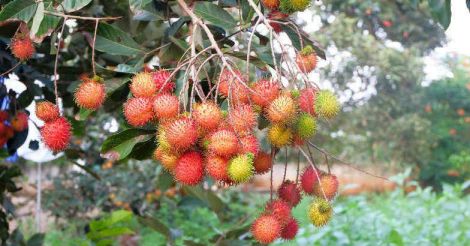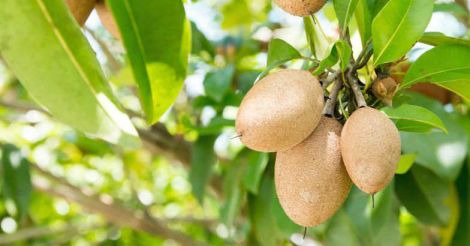Best Trees to Plant Near House in Kerala
There was in one case a time when every Keralite's lawn was replete with fruit bearing copse, herbs and medicinal plants. Wellness was just a step away from home. But the scenario is different nowadays. Today, it has come to a indicate, when nosotros have to depend on other neighboring states for bringing the fruits to our dining tables. Nigh often these are laced with harmful chemicals also. A daily intake of fruits is especially beneficial to improve the torso'south immunity and general well being. And did you know that all it takes to have a couple of copse in the m is most five cents of state. Then, why not try it? Nosotros bring yous a list of ten tress you can nurture for in your own backyard.
1. Rambutan

It is very rare to find a fruit store in Kerala that does non stock this exotic Southeast Asian fruit. The birth place of this tree that requires hot climates to thrive is Thailand. But, pocket-sized saplings that have been grafted are widely available at present. When using seeds, it will take around 8 years for the tree to mature. If you are purchasing the grafted establish, it should be atleast ii years sometime. A fully grown tree bears fruits in 2 years time. At that place are both male person and female person Rambutan trees. It is merely the female trees that gives fruits, and then ensure this earlier yous buy. The grafted plants stay in medium peak and don't abound into large trees. To forestall bats or squirrels, use a cyberspace to embrace the tree. Information technology is not plenty to put manure just at the pes of the plant, this should be done all around in 1 meter altitude so the roots grow sturdy. five cents is ample infinite to abound a Rambutan tree. The native Rambutan trees bear small sized fruits. It is the larger King variety fruit that is in much demand.
ii. Pulasan/Philosan
The outer skin of Rambutan is covered in spikes, whereas that of the Pulasan fruit is total of modest mounds. The taste of both fruits is quite similar. The method of intendance is same also. When the Rambutan is bright red, this fruit has more than of a yellowish tint. Like the Rambutan, the Philosan requires sunny atmospheric condition to grow.
three. Sweetness Hog Plum
Locally known as the sweet Ambazham, this is a compact plant that is platonic for pocket-size spaces or for flats. This is unlike its sour analogue, and is actually sweet. This constitute can be grown in a pot for 4 to 5 years. The fruits are borne throughout the year and it grows in large bunches. The fruits should be plucked earlier the fibers sprout and when it turns dark green. The fruits tin be used to set up pickles, chutney or even fish curry.
four. Sapodilla / Sapota

Popularly known as the Chikkoo fruit, the mucilage required for chewing gums comes from this tree. If layering has been done, fruits are borne in one year fourth dimension. The pulp of the fruit tastes similar custard and has a velvety texture. The fruits are either cricket-ball or oval shaped. The oval shaped fruits are sweeter. To keep squirrels or birds away, each fruit should be covered separately. Diabetics are advised against consuming this due to the high sugar content of the fruit. Fruit bearing happens all through the yr and information technology is rich in fibre and vitamins.
five. Mangosteen

These big sized, extremely sweetness fruits are native to Indonesia. Slight sloped areas where there is plenty of h2o is ideal for Mangosteen cultivation. The h2o should be drained off well and not form puddles in the holes around the modest saplings. The best time to plant these trees is between June to October. The manure treatment can start when the small-scale plants sprout and it begins to mature. Organic manure or Sterameal fertilizers can be used. Avoid chemical fertilizers. The growth of Mangosteen is slow comparatively and it requires shade in the start stages. The plant needs watering at intervals. The flowering period is from December to January commonly. Fruits are borne in 120 to 150 days time.
6. Thailand Rose Apple tree
There are many varieties of Rose Apple / Chambakka trees and this is a fairly recent entry. If layering or grafting has been done, it is easy to grow these trees. From Rs.500 per plant, the cost has come downwardly to Rs.100 for a plant. ane kilo Thailand Rose Apple are near viii fruits. The fruit resembles an elongated apple. There are no seeds for this constitute and fruits are borne all through the year. Usually Chambakka trees could be given a good milkshake to get the ripe fruits down, but Thailand Rose Apple tree is not like that. This fruit is ideal for juices. The Thailand Rose Apple tree Tree is smaller than the common Rose Apple Tree.
vii. Lemon driblet Mangosteen
The tropical American Lemon driblet Mangosteen tree is minor sized and apt as a garden tree. Fruits announced afterwards January time. The size of a gooseberry, the Lemon drib Mangosteen belongs to the Gambooge or Malabar Tamarind family unit. The white pulpy area around the seed is the edible role of this egg-shaped fruit. A pretty looking tree, it is also used as a decorative tree in the garden.
8. Gujarat Gooseberry
The usual diverseness Amla does not thrive likewise well in our climatic conditions. But a new variety that is native to Gujarat adapts quite well here. This variety of gooseberry is also chosen NA7. In that location are some guidelines to follow before grafting the Gujarat Gooseberry institute. The process basically involves attaching a wild plant with a amend Plant and in the case of the Gujarat Gooseberry, there are chances of the wild strain growing amend. The solution for this is to place the bespeak of grafting and cutting away the co-operative right below this point. The fruit begetting period is from September to Jan. These fruits are excellent to make wine. The bigger ones sense of taste improve but pocket-size gooseberries are more nutritious.
9. Jambul Tree
The fruit of this tree is available in enough hither. Merely a sweeter and seedless version of the Jamun fruit at present comes from Andhra Pradesh. Rich in antioxidants, the Jamun fruit is excellent as a cure for diabetes or heart ailments. This can be grown as a large tree or as a potted constitute too. The fruits are borne during the rainy season and hence almost fall off to the ground. In a pot, this problem is not there and it volition flower faster.
10. Star Gooseberry

The Star Gooseberry tree was one time very prevalent merely has almost vanished now. The fruits that grow in large bunches look like serial lights. The leaves look merely like those of curry leaves but is bigger. The tree does not require much sunlight and grows well in the shade of a larger tree. The fruit bearing time is after the rainy season. Specially used in the coastal areas, this is a great fruit to flavour prawn curry and sardine curry. According to Ayurveda, the Star Gooseberry is perfect for blood purification, for improving appetite and digestion related issues.
Things to call up
A 2 feet deep hole should be dug and the mud from this removed. Fill this with some top soil, cherry d, mud from the river bed & oil cakes fabricated from neem seeds. This neem mix helps to keep termites out. You can also add any other bio manures or a mixture of os meal with the neem cakes. Small holes of 2 feet deep should come near this to ensure that the root branches out well enough. Filling this with soil from the river bed is good for optimal root health. Non much pruning is required for grafted trees. The copse should exist spaced at a distance of atleast 10 metres from each. Copse grown from seeds take fourth dimension to flower and bear fruits, atleast 8 years minimum. Simply they accept better longevity. Grafted copse conduct fruit in 2 years time simply will not have much life span.
Information Courtesy: Dr. Jacob Varghese Kunthara, Home-grown Plant nursery & Farm, Kanjirapally
Source: https://www.onmanorama.com/lifestyle/news/10-fruit-bearing-trees-for-your-home-garden.html
0 Response to "Best Trees to Plant Near House in Kerala"
Post a Comment